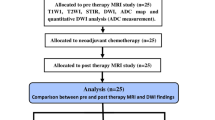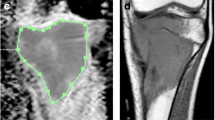Abstract
Background
During successful chemotherapy of osteosarcomas tumour size does not diminish significantly because the therapy has limited impact on the mineralized matrix of the tumour. Treatment response is considered successful if, histologically, more than 90% of tumour cells show necrosis.
Objective
To determine if osteosarcomas change their water diffusion during preoperative chemotherapy in relation to the amount of tumour necrosis.
Materials and Methods
Eight patients (age 11–19 years) with histologically proven limb osteosarcoma underwent T1-weighted, fat-suppressed T2-weighted and contrast-enhanced T1-weighted spin-echo imaging together with diffusion-weighted EPI sequences (b = 700) at 1.5 T before and after five cycles of standard chemotherapy. Tumour volume and apparent diffusion coefficient (ADC) maps were calculated before and after chemotherapy. The degree of tumour necrosis after chemotherapy was assessed using the histological Salzer-Kuntschik classification (grades 1–6).
Results
During chemotherapy, the ADC values of osteosarcomas changed significantly. The ADC of untreated tumour was 2.1 ± 0.4 × 10−3 mm2/s (mean ± SD) (95% CI 1.6–2.0). The ADC of chemotherapy-treated sarcomas was 2.5 ± 0.4 × 10−3 mm2/s (95% CI 1.8–2.2). Necrotic areas, which were confirmed by macroscopic examination, showed ADC values up to 2.7 × 10−3 mm2/s. Four patients with little viable tumour tissue within the neoplasm (Salzer-Kuntschik grades 1–2) had an increase in ADC of 0.4 up to 0.7 × 10−3 mm2/s. Four patients with larger areas of viable tumour (Salzer-Kuntschik grade 4) showed a lesser increase in ADC of 0.0 up to 0.3 × 10−3 mm2/s. The differences in ADC values in tumour tissue before and after chemotherapy were highly significant (P = 0.01).
Conclusion
During chemotherapy of osteosarcomas, tumour ADC changes are related to the degree of tumour necrosis.



Similar content being viewed by others
References
Hoffer FA, Nikanorov A, Reddick WE, et al (2000) Accuracy of MR imaging for detecting epiphyseal extension of osteosarcoma. Pediatr Radiol 30:289–298
Lang P, Johnston JO, Arenal-Romero F, et al (1998) Advances in MR imaging of pediatric musculoskeletal neoplasms. Magn Reson Imaging Clin N Am 6:579–604
Lang P, Wendland M, Saeed M, et al (1998) Osteogenic sarcoma: noninvasive in vivo assessment of tumor necrosis with diffusion weighted MR imaging. Radiology 206:227–235
Ross BD, Moffat BA, Lawrence TS, et al (2003) Evaluation of cancer therapy using diffusion magnetic resonance imaging. Mol Cancer Ther 2:581–587
Uhl M, Saueressig U, Kontny U, et al (2006) Osteosarcoma: preliminary results of in vivo assessment of tumour necrosis after chemotherapy with diffusion- and perfusion-weighted magnetic resonance imaging. Invest Radiol 41:618–623
Baur A, Reiser MF (2000) Diffusion-weighted imaging of the musculoskeletal system in humans. Skeletal Radiol 29:555–562
Parker GJ (2004) Analysis of MR diffusion weighted images. Br J Radiol 77:S176–S185
Salzer-Kuntschik M, Brand G, Delling G (1983) Determination of the degree of morphological regression following chemotherapy in malignant bone tumors. Pathologe 4:135–141
Sanchez RB, Quinn SF, Walling A, et al (1990) Musculoskeletal neoplasms after intraarterial chemotherapy: correlation of MR images with pathologic specimens. Radiology 174:237–240
Thoeny HC, De Keyzer F, Vandecaveye V, et al (2005) Effect of vascular targeting agent in rat tumor model: dynamic contrast-enhanced versus diffusion-weighted MR imaging. Radiology 237:492–499
Thoeny HC, De Keyzer F, Chen F, et al (2005) Diffusion-weighted MR imaging in monitoring the effect of a vascular targeting agent on rhabdomyosarcoma in rats. Radiology 234:756–764
Theilmann RJ, Borders R, Trouard TP, et al (2004) Changes in water mobility measured by diffusion MRI predict response of metastatic breast cancer to chemotherapy. Neoplasia 6:831–837
Deng J, Miller FH, Rhee TK, et al (2006) Diffusion weighted MR imaging for determination of hepatocellular carcinoma response to yttrium-90 radioembolization. J Vasc Interv Radiol 17:1195–1200
Author information
Authors and Affiliations
Corresponding author
Additional information
Supported by Grant DFG# u103
Rights and permissions
About this article
Cite this article
Uhl, M., Saueressig, U., Koehler, G. et al. Evaluation of tumour necrosis during chemotherapy with diffusion-weighted MR imaging: preliminary results in osteosarcomas. Pediatr Radiol 36, 1306–1311 (2006). https://doi.org/10.1007/s00247-006-0324-x
Received:
Revised:
Accepted:
Published:
Issue Date:
DOI: https://doi.org/10.1007/s00247-006-0324-x




